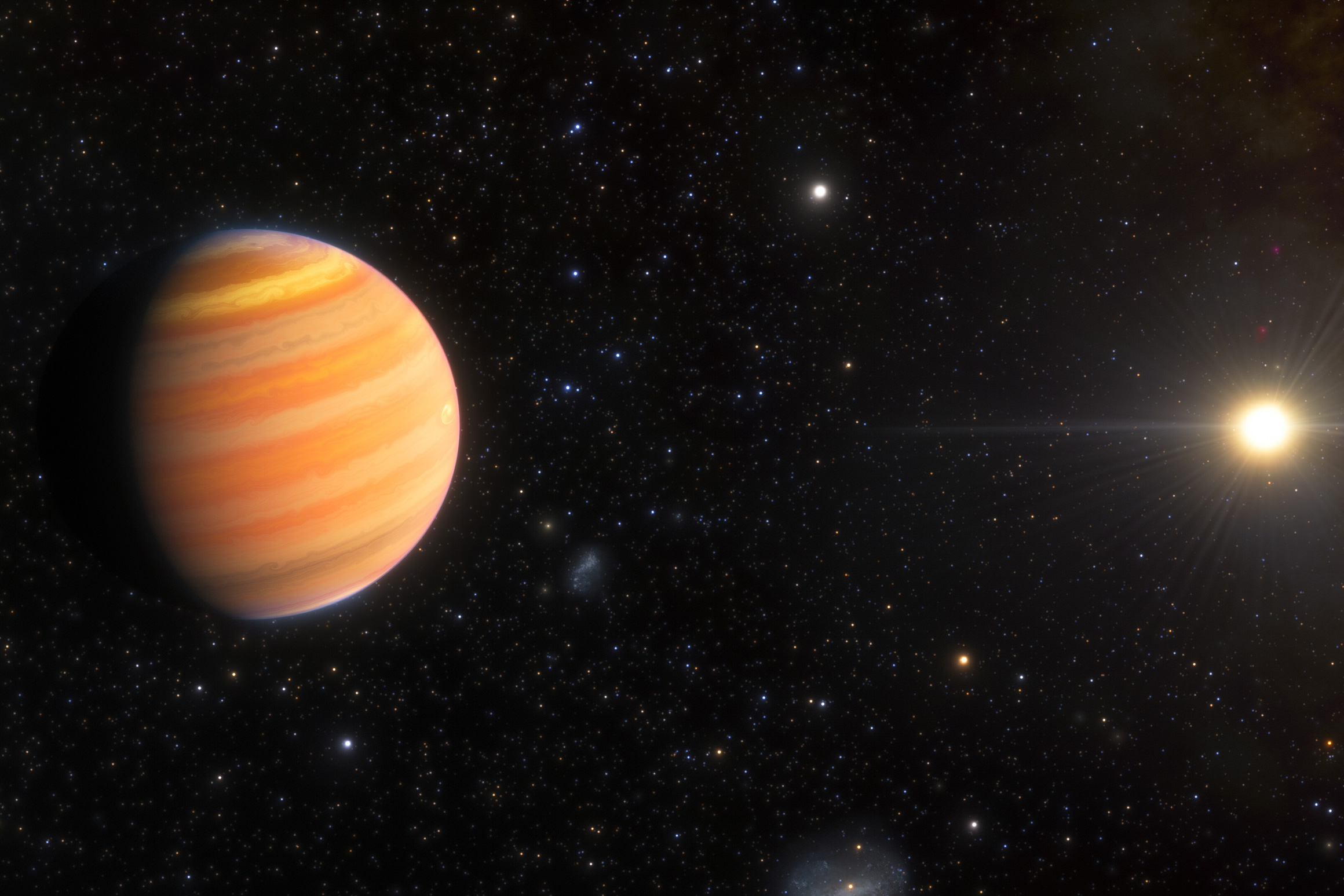Hot Jupiters represent the extremes of planetary existence, boasting mass similar to Jupiter yet orbiting their stars at breakneck speeds—completing a full orbit in just a few days compared to Jupiter’s leisurely 4,000-day journey around our sun.
Interestingly, scientists theorize that these scorching giants might not have always been this way. In fact, they could have originated as “cold Jupiters,” forming in distant, icy regions of space. The transition from their frigid beginnings to their current fiery orbits remains shrouded in mystery.
Recent research conducted by astronomers at MIT and Penn State University has unveiled a hot Jupiter “progenitor”—a youthful planet on the path to becoming a hot Jupiter. This discovery sheds light on the evolutionary journey of these dramatic celestial bodies.
The newfound planet, designated TIC 241249530 b, resides approximately 1,100 light-years from Earth and orbits its star in a remarkably “eccentric” manner. This means it dramatically approaches its star before swinging far out into space, akin to an elastic band being pulled and released. If it were part of our solar system, it would come within 10 times closer to the sun than Mercury, then shuttle out past Earth before looping back. Remarkably, its orbit holds the record for the highest eccentricity of any known planet.
Additionally, TIC 241249530 b features a unique “retrograde” orbit. In contrast to the planets in our solar system, which move in alignment with the sun’s rotation, this planet travels counter to its star’s spin.
The research team ran complex simulations to explore the dynamics of this extraordinary orbit, suggesting that it is a precursor to a hot Jupiter’s formation through a process called “high-eccentricity migration.” This migration method involves a planet’s orbit wobbling and progressively collapsing due to gravitational interactions with another celestial body that orbits further out.
In TIC 241249530 b’s case, astronomers uncovered that it orbits a primary star, which in turn orbits a second star within a binary system. The gravitational interplay between these two stars has gradually pulled the planet closer to its primary star.
Currently, TIC 241249530 b has an elliptical orbit and takes approximately 167 days to complete a revolution around its star. Researchers predict that in one billion years, it will settle into a tighter, circular orbit, completing its transformation into a hot Jupiter that orbits its star every few days.
“This new planet supports the theory that high eccentricity migration accounts for a portion of hot Jupiters,” says Sarah Millholland, an assistant professor of physics at MIT’s Kavli Institute for Astrophysics and Space Research. “We believe that it began as a cold planet and, due to its extreme orbital dynamics, will evolve into a hot Jupiter with temperatures soaring to several thousand kelvins. This represents a dramatic transformation from its origin.”
Millholland and her colleagues published their findings in the journal Nature, alongside contributions from MIT undergraduate Haedam Im, lead author Arvind Gupta from Penn State University, and collaborators from various institutions.
Unpredictable Seasons
This emerging planet was initially detected by NASA’s Transiting Exoplanet Survey Satellite (TESS), a mission led by MIT to monitor stars for transient starlight dips, which may indicate planets passing in front of them.
On January 12, 2020, TESS indicated a potential transit of the star TIC 241249530. Gupta and his team confirmed that the transit matched the presence of a Jupiter-sized planet, subsequently validating its highly eccentric orbit through radial velocity measurements from additional observatories.
Before this discovery, astronomers only knew of one other candidate, HD 80606 b, which was considered an early hot Jupiter, holding the eccentricity record until now.
“This new planet undergoes drastic variations in starlight during its orbit,” Millholland explains. “It must experience extreme seasonal changes and a scorched atmosphere each time it nears its star.”
Orbital Interplay
But how could a planet find itself in such an extreme orbit? To explore this, Im and Millholland conducted simulations to model the planet’s historical evolution and its future trajectory over millions of years.
The team focused on the gravitational dynamics of the planet, its star, and the secondary star in the binary system. They likened the orbital configuration to a circus performer spinning a hula hoop around her waist while simultaneously twirling another hula hoop around her wrist.
Through multiple simulations with varying initial conditions, the researchers sought to replicate the current arrangement of the planet and stars, then projected these models into the future to predict orbital evolution over billions of years.
These simulations indicate that the planet likely began as a cold Jupiter far from its star, initially orbiting in a circular pattern. However, gravitational forces from the binary star system gradually altered its path, creating an increasingly eccentric orbit.
“This process leads to significant changes in the planet’s orbit over time,” notes Millholland. “It’s a fascinating dance of orbits occurring over billions of years, with the planet simply going along for the ride.”
In another billion years, projections suggest that its orbit will stabilize into a tight circular path around its star, marking the completion of its transformation into a hot Jupiter.
The team’s findings and simulations reinforce the theory that hot Jupiters can arise through high eccentricity migration, highlighting a narrative of how celestial bodies can evolve dramatically through time.
“This and other studies suggest that high eccentricity migration should account for a fraction of hot Jupiters,” Millholland emphasizes. “This system underscores the astonishing diversity of exoplanets, revealing wild orbits and their progression towards the future. For this planet, the journey is still underway.”
As Smadar Naoz, a professor of physics and astronomy at UCLA, points out, “Capturing these hot Jupiter progenitors ‘in the act’ during their intricate orbital evolution is challenging, making this discovery especially thrilling. It paves the way for deeper insights into the formation of exoplanetary systems.”
Photo credit & article inspired by: Massachusetts Institute of Technology



